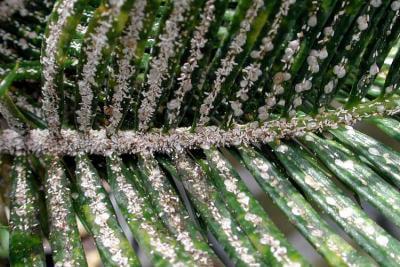
NOTE: this pest is not known to spread in or on firewood. It is included in the Gallery of Pests for general information purposes only.
The Micronesian cycad (Cycas micronesica) is a palmlike woody plant native to Micronesia, the Marianas Group including Guam and Rota Islands; and several of the western Caroline Islands, e.g., Palau and Yap (Marler, Haynes, and Lindstrom 2010).
In 2003, officials noticed that cycads planted near hotels on Guam had begun to die. The cause was found to be an Asian scale native to Thailand and southern China. Beginning in the 1990s, the scale began spreading through the horticultural trade: it was detected in Florida in 1996, in Hawai`i in 1998. As noted, it was detected on Guam in 2003 (Brooke pers. comm.). Cycad scale has since spread to Rota (in 2007) and Palau (in 2008) (University of Guam 2012). Spread continues; by 2020, the scale is distributed globally, including numerous islands and neighboring mainland areas in the Caribbean (including Puerto Rico and the US Virgin Islands), several U.S. states in the Southeast, California, and Hawai`i; South Africa, Taiwan, and other Pacific islands. (Moore, Marler, Miller, and Yudin) See map here from CABI. On Taiwan, the scale threatens another rare cycad species, Cycas taitungensis (CABI 2019). In South Africa, numerous native cycads in the Encephartos genus are at risk; they cycad was introduced despite being listed as a prohibited species (vanWilgen, et. al. 2020).
The scale’s spread via trade in horticultural plants is difficult to contain by standard phytosanitary measures – visual inspection – because the scale is tiny and hides deep in the base of the plant’s stiff leaves and other crevices (Marler and Moore 2010). Since scales persist even beneath the leaf bases (trichomes), the only way to prevent spread to new territory is to deny importation of any susceptible cycad species (Marler pers. comm.).
By 2005 the scale was found in Guam’s forest habitat on the native cycad species, Cycas micronesica. The tree, called “fading” in the Chamorro language spoken on Guam, was the dominant forest tree on the island of Guam until arrival of the scale. Within four years, the millions of C. micronesica on Guam were reduced by more than 90% (Marler, T.E. and K.J. Niklas. 2011).
Other invasive species are contributing to plant mortality (University of Guam 2012). These include (IUCN Red List of Threatened Species Online 2008)
- the cycad blue butterfly (Chilades pandava), which was detected in 2005 and quickly spread throughout Guam;
- the epidemic longhorn beetle (Dihammus (Acalolepta) marianarum), which causes stem damage;
- a snail (Satsuma mercatorius), which recently began feeding on young leaflets
Another invasive species, the termite Schedorhinotermes longirostris, is from the Indo-Malayan region. It was detected in 2011. The termites weaken the cycad stems, which are then toppled by feeding introduced deer. The termites are also damaging the cycad’s reproductive structures (megastrobili). Termite attacks on cycads are unexpected since they do not form true wood. The termite had probably been introduced recently because, as of 2011, it had been detected only near the Andersen Air Force Base airport (Marler, Yudin, and Moore 2011).
The last time cycads on the island reproduced in any significant number was in 2004 (Marler and Niklas 2011). The severe impact of the scale was so rapid that the International Union for Conservation of Nature and Natural Resources (IUCN) changed its listing of C. micronesica from “near threatened” in 2003 to “endangered” in 2006 (IUCN Red List of Threatened Species Online 2008).
Scientists have made several attempts to find a biocontrol agent. None has provided sufficient control. A lady beetle Rhyzobius lophanthae established quickly and initially appeared to be effective in controlling the scale (Marler and Moore 2010). However, although the beetle is now ubiquitous on Guam, it has not provided sufficient control because it is too big to reach the significant proportion of the scale insects which live in small cracks and voids within the plant structures. The beetle also doesn’t prey on scale insects living beneath trichomes or on parts of the plant close to the ground (Marler and Moore 2010).
The University of Guam team tried to introduce a second biocontrol organism – the parasitoid wasp Aphytis lignanensis. However, establishment of the wasp has been stymied by the presence of R. lophanthae (Marler and Moore 2010).
Despite these many threats, the Guam cycad was described as “common” in 2020 (A. Moore, pers. comm.).
SOURCES
Brooke, USFWS, pers. comm. June 3, 2005
CABI November 2019. Aulacaspis yasumatsui (cycad aulacaspis scale (CAS)) or the Asian cycad scale. https://www.cabi.org/isc/datasheet/18756
International Union for Conservation of Nature (IUCN) Species of the Day factsheet need URL Accessed 22 April, 2020.
Marler, T.E. pers. comm. August 15, 2012
Marler, T.E. 2010. Cycad mutualist offers more than pollen transport. American Journal of Botany, 2010; 97 (5): 841. Viewed as materials provided by University of Guam, via EurekAlert; accessed 6 August, 2012.
Marler, T.E., and A. Moore. 2010. Cryptic Scale Infestations on Cycas revoluta Facilitate Scale Invasions. HortScience. 2010; 45 837-839. Retrieved August 6, 2012 from www.eurekalert.org
Marler, T.E., L.S. Yudin, A. Moore. 1 September 2011. Schedorhinotermes longirostris (Isoptera: Rhinotermitidae) on Guam Adds to Assault on the Endemic Cycas micronesica. https://bioone.org/journals/florida-entomologist/volume-94/issue-3/024.094.0339/Schedorhinotermes-longirostris-Isoptera–Rhinotermitidae-on-Guam-Adds-to-Assault/10.1653/024.094.0339.full
Marler, T.E. and K.J. Niklas. 2011. Reproductive Effort and Success of Cycas micronesica K.D. Hill Are Affected by Habitat. International Journal of Plant Sciences, 2011; 172 (5): 700. Viewed as materials provided by University of Guam, via EurekAlert; accessed 6 August, 2012.
Moore, A., T. Marler, R. Miller, and L. Yudin. Date? Biological Control of Cycad Scale, Aulacaspis yasumatsui, Attacking Guam’s Endemic Cycad, Cycas micronesica. Western Pacific Tropical Research Center University of Guam https://guaminsects.myspecies.info/sites/guaminsects.myspecies.info/files/CycadScaleBiocontrolAustin.pdf
University of Guam (2012, August 2). Invasive insects cause staggering impact on native tree. ScienceDaily. Retrieved August 6, 2012, from www.sciencedaily.com-/releases/2012/08/120803094527.htm).
vanWilgen, B.W.,J. Measey, D.M. Richardson, J.R. Wilson, T.A. Zengeya. Editors. 2020. Bioinvasions in South Africa. Invading Nature. Springer Series in Invasion Ecology 14.



